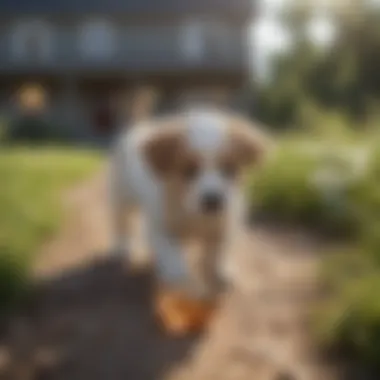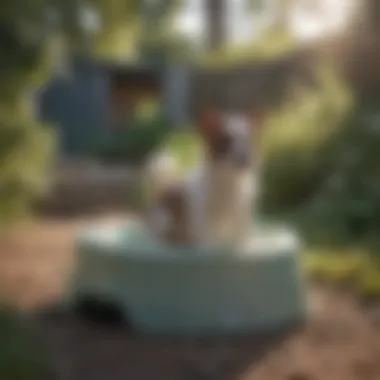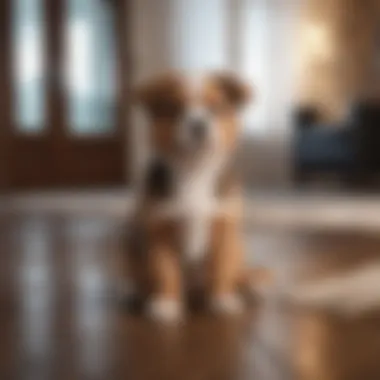Effective House Training for Your Puppy Without a Crate


Intro
House training a puppy is a significant aspect of pet ownership. Many owners may consider crates as a primary tool in this process. However, it's entirely feasible to achieve effective training without resorting to crate confinement. This approach fosters better communication between the pet and the owner. It also nurtures a positive learning environment that can greatly enhance the training experience.
This guide outlines essential methods and considerations for house training your puppy. It emphasizes key strategies that promote a deeper understanding of your puppy's needs. By focusing on their body language and behavior, you create a nurturing space for learning.
Pet Care Essentials
Daily Nutrition Requirements
Proper nutrition is critical in promoting a healthy growth and development for your puppy. Understanding the dietary needs of your puppy is vital. Ensure to provide them with high-quality commercial puppy food that is rich in essential nutrients. Puppies generally require a diet higher in calories than adult dogs. This is necessary to support their energy needs. Additionally, feeding practices should be consistent, serving meals at scheduled times each day. This can contribute to a healthier digestion and routine.
Exercise and Playtime
Physical activity is essential not only for physical health but also for mental stimulation. Puppies have high energy levels. Regular exercise helps to reduce behavioral issues associated with boredom. Engage your puppy in daily walks, fetch games, or interactive play. These activities not only provide exercise but also fortify the bond between you and your puppy.
Grooming Tips
Maintaining your puppy’s grooming needs is another essential part of care. Proper grooming helps prevent skin infections and matting. Depending on the breed, brush your puppy regularly. Bathing should happen as needed, using gentle, dog-specific shampoos. Nail trimming is also crucial and should be performed regularly to avoid overgrowth that can cause discomfort.
Health and Wellness Check-ins
Regular check-ups with a veterinarian are crucial in monitoring your puppy’s health. These visits can also help catch potential issues early on. Vaccinations, parasite control, and wellness exams play a significant role in keeping your puppy healthy. Familiarize yourself with the recommended vaccination schedule specific to your dog's breed and size.
Behavior & Training
Understanding Your Pet's Body Language
Recognizing your puppy’s body language is fundamental in understanding their needs and emotions. Pay close attention to behaviors such as tail wagging, ears position, and eye contact. These signs can indicate whether your puppy is anxious, excited, or content. Being attuned to these signals can enhance your training effectiveness significantly.
Basic Training Techniques
Training should begin early, ideally at the puppy stage. Use positive reinforcement methods such as treats, praise, or playtime to encourage desired behaviors. Consistency is key; establish a set routine for potty breaks. Take your puppy outside frequently, especially after meals or play.
Remember: Patience is crucial. Puppies may take time to learn, and mishaps will occur.
Behavioral Concerns & Solutions
It is normal for puppies to display unwanted behaviors such as chewing or barking. Identifying the root cause of these behaviors can guide you in providing effective solutions. Redirecting their attention to appropriate toys and providing ample exercise can minimize destructive behaviors. Always approach training with calmness and understanding.
Socialization Tips
Socialization is vital in developing a well-rounded puppy. Introduce your puppy to various environments, people, and other animals. This exposure should be positive and gradual. A well-socialized puppy tends to have a better temperament and adjusts more easily to new experiences.
Pet Home Environment
Creating a Pet-friendly Space
Designing a pet-friendly home involves creating an area dedicated to your puppy. Ensure this space is safe, clean, and comfortable. Remove hazards such as toxic plants, small objects, or wires that your puppy might chew on. Having a designated spot for your puppy can help them feel secure, aiding in the training process.
Safety Measures and Hazards to Avoid
Safety should always be a priority. Use baby gates to restrict access to certain areas. Keep dangerous items such as cleaning products out of reach. It’s also advisable to research poisons, like certain foods or plants toxic to dogs, to ensure your home is secure.


Choosing the Right Toys and Accessories
Select toys that are appropriate in size, texture, and durability. Puppies often enjoy chew toys, plush toys, and balls. It’s important to supervise playtime, ensuring your puppy’s toys are safe and free from small parts that can pose a choking hazard.
Setting Up a Comfortable Resting Area
A comfortable resting area allows your puppy to relax and recharge. Provide a soft bed in a quiet corner free from disturbances. Consider placing blankets or familiar items to create a comforting environment. This designated area can also assist in establishing a routine for your puppy’s rest time.
Culmination
House training a puppy without a crate is completely achievable with the right approach. By focusing on nutrition, exercise, behavior, and environment, you lay a solid foundation for a well-trained pet. Remember to foster communication, patience, and understanding throughout the process, ensuring a happy and healthy relationship with your puppy.
Foreword to House Training Without a Crate
House training is a vital aspect of puppy ownership. It is essential for creating a happy and harmonious living environment. Many pet owners worry about how to house train their puppies. Often, people consider crates as a primary method. However, training your puppy without a crate is feasible and can lead to effective results. This approach takes into account the puppy’s emotional well-being, which is crucial during the formative stages of their life.
Choosing to house train without a crate can enhance the bond between the owner and the puppy. It encourages better communication and understanding between them. Owners are more attuned to their puppy’s needs, making the process smoother. The journey is about building trust and ensuring a positive experience for the puppy during training.
This article will explore effective methods and strategies that prioritize the puppy's comfort and growth. It will also address common challenges that may arise during training. The goal is to lay down a solid foundation. A well-trained puppy will lead to a rewarding dynamic in a household.
Understanding the Concept of House Training
House training refers to the process of teaching a puppy to relieve itself in designated areas. This can be outdoors or on indoor pads. The training focuses on instilling appropriate habits while ensuring the puppy feels secure. Consistency and patience are critical components of this training. The puppy must learn to associate specific cues or environments with the act of elimination.
Puppies thrive on routine. Establishing a predictable schedule for bathroom breaks can aid in their understanding. It's also important to remember that accidents will happen. They are a natural part of the learning process. Keeping a positive outlook will support the puppy on its path to successful training.
Benefits of Training Without a Crate
House training without a crate offers several advantages for both the puppy and its owner. First, it creates a less stressful environment for the puppy. Crates can induce anxiety, especially for sensitive dogs. When trained without them, puppies often feel more freedom and confidence. This can foster a positive learning atmosphere.
Second, it builds a strong bond between the owner and the puppy. Without the crate as a physical barrier, the puppy can see the owner as a source of guidance and trust. Training becomes a joint effort, where both experience successes together.
"Establishing trust with your puppy through consistent, crate-free methods advances both training and your relationship with them."
Lastly, training without a crate often allows for flexible strategies. Owners can adapt their methods to suit their living conditions and the puppy’s unique behavior. This adaptability leads to more personalized training approaches, enhancing overall effectiveness.
Essential Principles of Puppy House Training
House training a puppy without a crate requires a solid understanding of several essential principles. Establishing a routine is fundamental for success. A predictable schedule provides your puppy with a framework for when to eat, play, and relieve themselves. This predictability instills confidence and reduces anxiety for the puppy. Additionally, a consistent routine promotes healthy habits, making it easier for the puppy to understand what is expected.
Another key principle involves understanding puppy behavior. Puppies naturally have specific needs and signals that indicate their desire to go outside. Being attentive to these signals allows owners to respond promptly, reinforcing desired behaviors. Puppies, similar to young children, learn through observation and mimicry. Thus, understanding their behavior patterns is critical in facilitating effective training.
Positive reinforcement plays a vital role in the training process. By rewarding good behavior, such as going outside or using designated potty areas, you encourage your puppy to repeat those actions. This method not only strengthens the bond between the owner and the pet but also fosters a trusting relationship. Puppies respond better to encouragement rather than punishment, making positive reinforcement a cornerstone of effective training.
In summary, the principles of establishing a routine, understanding puppy behavior, and employing positive reinforcement create a strong foundation for successful house training. Integrating these principles fosters an environment that promotes learning and builds good habits, ensuring a smoother experience for both the puppy and the owner.
Creating a Welcoming Environment
Creating a welcoming environment is essential for effective house training of your puppy. A positive atmosphere can significantly help in conditioning your puppy to become familiar with appropriate elimination habits. This approach goes beyond just physical space. It encompasses emotional comfort and a structured layout that supports the training process.
Designating a Potty Area
The first step in establishing a welcoming environment is designating a specific potty area for your puppy. This area should be easily accessible and away from the dog's play and rest zones. The selection of this area aids in reinforcing where your puppy should go to relieve themselves. Consider using the same spot outdoors or indoors, as consistency fosters learning.


When you introduce your puppy to this designated area, use a command or cue word. Puppies often respond well to such cues, which help them associate the location with doing their business. Make sure you take your puppy to this area regularly, especially after meals, naps, or playtime.
Minimizing Distractions
Another aspect of a welcoming environment is minimizing distractions during training. Puppies are naturally curious, and their attention can easily drift towards sounds, movements, or objects around them. Set up the training area in a location that is quiet and free from hectic activities. If possible, keep other pets away during potty training sessions to maintain focus.
Additionally, removing any clutter or toys from the designated potty area can help your puppy concentrate on the task at hand. Limiting distractions encourages your puppy to understand the reason behind why they are taken to that specific spot.
Utilizing Puppy Pads
Utilizing puppy pads can also contribute to creating a welcoming environment. Puppy pads are a practical solution, especially for indoor training. They offer a designated space for your puppy to relieve themselves when outside access is not feasible. Discover the right size of the pad for your puppy and place it in a convenient location.
Regularly changing the pads ensures cleanliness and reduces the chance of odors, which can deter your puppy. When using puppy pads, establish a routine to encourage your puppy to use them. Gently guide your puppy to the pads when you notice signs that they need to go. With time, many dogs become comfortable with using these pads instead of other areas in the house.
Consistency and a calm atmosphere are vital in house training. A supportive environment significantly enhances the learning process.
In summary, creating a welcoming environment involves designating specific potty areas, minimizing distractions, and utilizing puppy pads. This supportive framework is integral to successful house training without a crate.
Training Techniques and Strategies
Training techniques and strategies play a crucial role in house training a puppy without using a crate. They are designed to instill good habits and encourage effective communication between the puppy and owner. A structured approach during this formative stage can lead to successful outcomes. Specific techniques enhance understanding and obedience, while also strengthening the bond between pet and owner.
Successful training requires a clear understanding of the puppy's needs. Puppies thrive in environments where they feel secure. Techniques that prioritize regular outdoor breaks and reinforce positive behavior create a supportive atmosphere. With these methods, you can help your puppy learn appropriate potty behavior more efficiently.
Frequent Outdoor Breaks
Providing frequent outdoor breaks is an essential component in transitioning a puppy to suitable toilet habits. Puppies have small bladders and cannot hold their urine for extended periods. Noticing this, it is necessary to take your puppy outside every two hours, especially after meals or naps. The goal is to instill a routine that encourages your puppy to associate going outside with relieving themselves.
When you bring your puppy out, positively reinforce this behavior with praise or treats. For instance, if your puppy successfully goes potty on the grass, use a calm but excited tone to express approval. This connection between the action and the reward helps your puppy understand the purpose of the outdoor breaks.
Monitoring Signs of Need
Every puppy displays certain signs when they need to go outside. It is essential to learn these cues. Common behaviors include sniffing, circling, whining, or resting by the door. Pay close attention to your puppy's actions after meals or waking up. Recognizing these signs allows you to be proactive rather than reactive and avoids unwanted accidents inside the house.
Creating a watchful routine involves observing your puppy closely. When these signs are observed, react quickly by taking the puppy outside. This timely response reinforces the understanding that their needs will be met promptly.
Scheduled Bathroom Breaks
In addition to responding to signs of need, scheduled bathroom breaks are an important part of the training process. Designate specific times throughout the day for bathroom breaks, regardless of whether the puppy shows signs of needing to go or not. For example, taking the puppy out first thing in the morning, after each meal, and just before bedtime can establish a regular routine that encourages consistency.
This strategy helps the puppy learn to anticipate bathroom breaks. Over time, the puppy will be more likely to go outside during these scheduled times.
Redirecting Errors Safely
Mistakes are a natural part of any training process, and puppies are no exception. When accidents happen in the house, it is important to handle them calmly and effectively. Instead of scolding or showing frustration, gently redirect the puppy to the designated potty area outside.
If your puppy does have an accident indoors, clean the area thoroughly using an enzymatic cleaner. This step is critical, as lingering odors can signal to the puppy that it is an acceptable place to relieve itself. Thus, avoiding anger helps maintain the trust between you and your puppy, fostering a more positive training experience.
Training a puppy requires patience, understanding, and consistency. Using the right techniques is essential for successfully teaching your puppy house manners.
Dealing with Common Challenges
Training a puppy can bring various obstacles. As much as one prepares and anticipates, incidents are likely to occur. Understanding common challenges is essential. This will help in fostering patience and resolving issues without unnecessary stress.


Accidents Inside the House
Accidents are a normal part of house training. Whether it's a small puddle on the floor or a larger mess, it is crucial to remain calm. Puppies often do not have full control over their bladder or bowels yet. When an accident happens, don’t scold the puppy. Such reactions can cause fear or anxiety about elimination, making training harder. Instead, clean the area thoroughly to remove scents that might encourage repetitive accidents. Use enzymatic cleaners designed for pet messes to ensure odors are completely eliminated. Moreover, redefining the routine might be necessary. Frequent breaks can aid in decreasing accidents and build good habits.
Inconsistent Training Methods
Inconsistency is one of the largest hurdles in house training. If one day a puppy is rewarded for going outside and the next day accidents are punished, the puppy becomes confused. It is vital to establish a clear training approach and stick to it. All family members should be on the same page. This ensures the puppy receives consistent commands and feedback. A training schedule can also help keep everything organized. Consistency breeds understanding. Ensure that rewards and commands for good behavior are recognized every time.
Addressing Fear and Anxiety
Fear and anxiety can significantly impact house training efforts. Some puppies may be sensitive to loud noises or sudden movements, leading to accidents. If a puppy is anxious about going outside, they may delay elimination until back indoors. It is essential to create a calm environment. Encourage outdoor activities using soft tones and gentle movements. Gradually introduce the puppy to various sounds and environments. This can help build their confidence. Consider incorporating positive reinforcement to reduce fear. When the puppy goes outside calmly and performs, provide treats and praise. It builds a positive association with outdoor potties and encourages relaxation.
"Understanding a puppy's needs and fears is key to successful house training.
By recognizing these common challenges, owners can adapt their methods. Each puppy is unique and may require different approaches. Patience is essential. With continued effort, even troublesome situations can turn into effective learning opportunities. The pivotal point is to focus on the puppy's well-being, supporting growth and fostering trust.
Monitoring Progress and Adjustments
Monitoring the progress of house training is crucial to ensure successful outcomes. An awareness of how the puppy is adapting to training methods allows for informed decisions about adjustments in technique. Progress not only involves how often the puppy goes outside but also how consistently it returns to the designated potty area and recognizes cues from the owner. By keeping a close eye on these elements, the owner can identify effective practices and areas needing refinement.
Keeping a Training Journal
A training journal plays an invaluable role in tracking achievements and identifying challenges. Documenting each training session allows the owner to see patterns emerge. It can include notes on the puppy's behavior, feeding times, bathroom breaks, and any accidents that occur. Describing the circumstances that lead to mistakes can provide deeper insights into behavioral triggers.
Some details to include in the journal:
- Time of Day: Record when bathroom breaks are successful or when accidents happen.
- Puppy’s Behavior: Note any signs that indicate the puppy needs to go out, such as pacing or whining.
- Rewards Given: Specify which rewards were used for positive reinforcement during training sessions.
- Overall Attitude: Jot down how your puppy responds to training each day.
This information creates a detailed account that can lead to strategic adjustments in trainin.
Recognizing Milestones
It's essential to celebrate milestones during the house training journey. Recognizing small achievements boosts motivation and confidence, both for the puppy and the owner. Milestones might include:
- Using the potty area consistently for a week.
- Responding to cues without prompting.
- Completing a session without accidents.
- Learning the designated bathroom spots outside or on pads.
Documenting these milestones in the training journal also helps to remind owners of progress made. Each small success offers an opportunity to reinforce positive behaviors and build upon them, leading to a well-trained, confident puppy.
Adjusting Techniques As Needed
Flexibility in training methods is paramount. Not every puppy learns at the same pace, so adapting techniques according to individual needs is vital. Here are some considerations:
- Reassess your Routine: If your puppy is having frequent accidents, it may indicate that the routine needs adjusting. More breaks or earlier cues may be required.
- Modify Rewards: Evaluate the effectiveness of the rewards being used. Some puppies may respond better to toys than treats, or vice versa.
- Environmental Changes: If distractions are a common issue, consider changing the training location. Training in a quieter, more controlled space could improve focus.
Adjustments are not signs of failure, but stepping stones towards a successful training outcome.
In summary, monitoring progress and making adjustments along the way are fundamental to effective house training. Using a journal to track behaviors, acknowledging milestones, and adjusting techniques as necessary lays a solid foundation for a strong owner-puppy bond.
End
In summary, effective house training without a crate is both achievable and rewarding for both the puppy and the owner. This approach emphasizes understanding the puppy's needs, establishing routines, and creating a structured environment where the puppy can learn effectively. The absence of a crate might seem daunting initially, but it allows for a more communicative relationship based on trust and observation.
Recap of Key Points
- Routine is Essential: Puppies thrive on schedules. Regular potty breaks and feeding times help them understand what is expected.
- Positive Reinforcement Works: Rewarding good behavior significantly enhances learning. Using treats, praise, or playtime as rewards reinforces the correct behavior and encourages repetition.
- Recognize Signs of Need: Being attentive to your puppy's signals can prevent accidents. Common signs include circling, whining, and sniffing around.
- Adapt to Needs: Each puppy is unique. Adjust methods based on individual behaviors, preferences, and temperaments.
Final Thoughts on Puppy Training
Training a puppy is not merely about establishing bathroom habits; it is about fostering a bond. The final thoughts hinge on patience, consistency, and love. By being proactive and aware, pet owners can cultivate an environment conducive to learning while ensuring the puppy feels secure. Remember that mistakes are part of the process. The goal isn't perfection but rather mutual understanding.
"Patience is not simply the ability to wait - it's how we behave while we're waiting."







